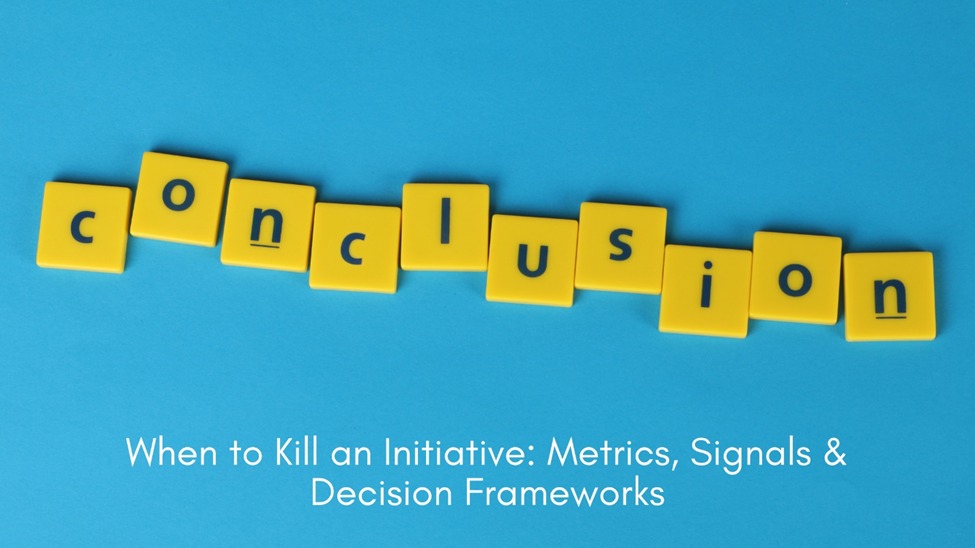
The Toughest Call a CIO Has to Make
Every CIO and transformation leader faces the same dilemma, when do you stop an initiative that’s consuming time, talent, and capital, but no longer delivering impact?
Pulling the plug on an initiative isn’t failure.
It’s leadership maturity.
In fact, Gartner’s 2024 Strategy Execution Report notes that over 42% of digital initiatives should be either paused or terminated before completion, yet less than 10% actually are.
Why?
Because enterprises confuse effort with progress, and visibility gaps blur judgment.
The result:
Projects keep running months after value has evaporated.
Resources stay locked in “zombie initiatives.”
Strategic bandwidth gets hijacked by sunk costs.
“Killing an initiative is not about loss, it’s about reclaiming focus.”
Why Organizations Struggle to Stop Initiatives
CIOs rarely lack data they lack decisive signals.
Most dashboards track activity metrics, not outcome indicators. Teams show progress reports, not business impact.
By the time leadership realizes an initiative isn’t working, millions have already been spent.
Let’s break down the common reasons organizations hesitate:
1. Sunk Cost Bias
Humans hate admitting waste.
The more invested a company becomes, the harder it is to walk away, even when the outcome is clearly suboptimal.
2. Political Capital
Initiatives are often tied to leadership reputations. Killing one can seem like undermining a sponsor’s credibility, so teams keep it alive to “manage optics.”
3. Lack of Governance Triggers
Without predefined metrics or decision checkpoints, there’s no formal moment to review continuation versus closure.
4. Absence of Visibility
When reporting happens across tools Jira, Excel, Power BI without alignment to strategy, warning signals get buried.
Knowing When to Pull the Plug: The Signals
Just as pilots rely on flight instruments, CIOs must rely on execution intelligence not intuition to know when to stop an initiative.
Here are the five universal signals that indicate it’s time to rethink, pause, or terminate:
1. Strategic Misalignment
When the initiative no longer ties to organizational OKRs or business priorities.
Example: a compliance automation project that loses relevance due to regulatory changes.
📉 Metric: 0% alignment score in strategic mapping dashboards within Initiatives.app.
2. Value Drift
If the initiative’s expected ROI or outcome has degraded by over 30% and there’s no realistic recovery plan.
Example: cost of implementation exceeds potential benefit.
📉 Metric: ROI ratio below 0.7 or negative net benefit trend in quarterly dashboard.
3. Continuous Schedule or Scope Variance
Chronic slippages without re-baselining indicate structural issues.
Example: three consecutive milestone misses or >25% scope change requests.
📉 Metric: Deviation index > 25% across two cycles in Initiatives.app deviation tracker.
4. Governance Fatigue
When leadership reviews become ritualistic, same issues, no improvement.
If corrective actions repeat with no measurable progress, it’s a sign of initiative fatigue.
📉 Metric: Repetition rate of issues >50% with static risk heatmap for two months.
5. Opportunity Cost Spike
When keeping one initiative alive prevents funding or focus on more strategic ones.
Example: ₹2 crore trapped in a legacy upgrade that could fund AI pilots with faster ROI.
📉 Metric: Negative portfolio efficiency index or stagnant innovation velocity.
Remember: The courage to stop one wrong initiative enables ten right ones to thrive.
The Decision Framework: Evaluate, Pivot, or Terminate
CIOs need a structured framework that combines data + judgment + governance.
Here’s a 3-step approach widely used by high-maturity enterprises:
Step 1: Evaluate Is It a Performance Problem or Purpose Problem?
- If outcomes are lagging but purpose is still strategic, focus on intervention (resource reallocation, leadership coaching, tech upgrades).
- If the purpose is obsolete (e.g., replaced by new regulation or tech direction), it’s a purpose problem time to end it.
Initiatives.app’s Strategic Alignment Matrix helps you visualize this distinction instantly.
Step 2: Pivot Can It Be Redesigned to Recover Value?
Some initiatives can evolve instead of ending.
Example: repurposing a failed chatbot project into a knowledge automation engine.
Use Initiatives.app’s Change Request Governance to model the impact of a pivot before approval, so decisions are not emotional but evidence-backed.
Step 3: Terminate Execute a Controlled Shutdown
If continuation drains ROI and distracts teams, terminate gracefully.
Communicate learnings, reallocate resources, and update OKRs.
A well-documented closure builds trust and institutional wisdom.
Initiatives.app automatically captures closure reports, effort history, and benefit deviations for audit and reflection.
Smart closure is a leadership milestone not a setback.
Governance Intelligence: How Initiatives.app Enables Smart Decisions
Initiatives.app acts as your governance radar continuously monitoring initiative health and flagging deviations before they escalate.
H3 Key Features That Enable Data-Driven Termination Decisions
| Feature | Benefit |
| Alignment Dashboard | Measures real-time correlation of initiatives with OKRs |
| Deviation Alerts | Flags schedule, budget, and quality variances instantly |
| ROI Analyzer | Tracks cost vs. realized benefit |
| Change Request Impact Analysis | Evaluates if pivots are worthwhile |
| Closure Workflow Automation | Standardizes and documents initiative termination |
The Human Side: Reframing “Killing” as “Liberating”
Ending an initiative can feel politically risky but culturally, it’s liberating.
It signals maturity: your organization values outcome over optics.
CIOs who lead this shift gain credibility as strategic guardians not just project overseers.
Psychologically, it empowers teams too: they see leadership committed to focus, clarity, and impact, not endless cycles of status updates.
“Ending the wrong initiative doesn’t diminish ambition, it amplifies integrity.”
Conclusion: Leadership Is Knowing When to Let Go
Great CIOs don’t just start bold initiatives they also know when to stop them.
In a world of shrinking budgets and expanding portfolios, execution intelligence defines success.
Strategic courage means recognizing that velocity without direction is waste.
With Initiatives.app, you gain the metrics, signals, and governance framework to make those tough calls with confidence protecting not just your projects, but your organization’s strategic focus.
👉 Book a Demo | 🌐 Visit Initiatives.app
📥 Learn more about features, benefits, and use cases at:
👉 www.initiatives.app
Contact Us : info@whizible.com | +91 855-498-3315
Address : Mrugank, Level 3, Kothrud, Pune, Maharashtra, 411038